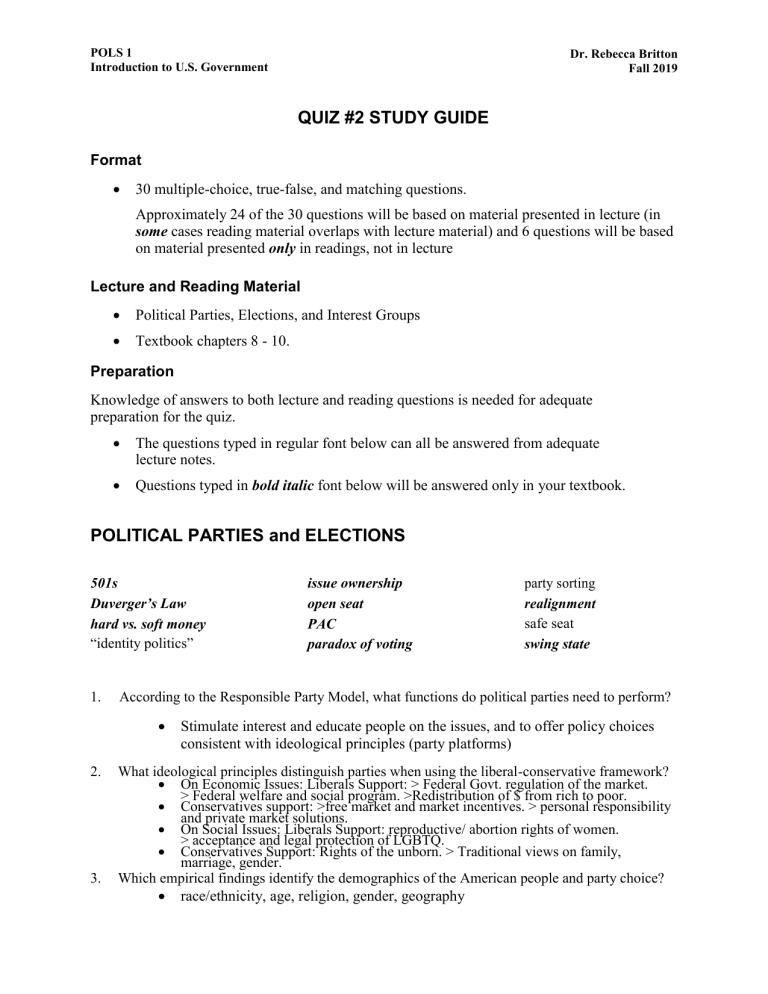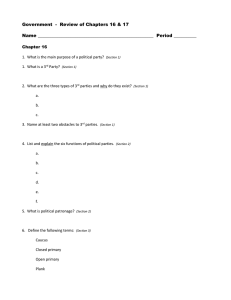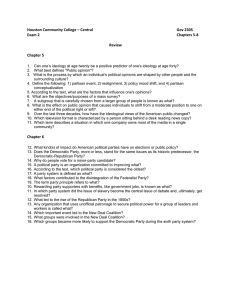
POLS 1 Introduction to U.S. Government Dr. Rebecca Britton Fall 2019 QUIZ #2 STUDY GUIDE Format 30 multiple-choice, true-false, and matching questions. Approximately 24 of the 30 questions will be based on material presented in lecture (in some cases reading material overlaps with lecture material) and 6 questions will be based on material presented only in readings, not in lecture Lecture and Reading Material Political Parties, Elections, and Interest Groups Textbook chapters 8 - 10. Preparation Knowledge of answers to both lecture and reading questions is needed for adequate preparation for the quiz. The questions typed in regular font below can all be answered from adequate lecture notes. Questions typed in bold italic font below will be answered only in your textbook. POLITICAL PARTIES and ELECTIONS 501s Duverger’s Law hard vs. soft money “identity politics” 1. 3. party sorting realignment safe seat swing state According to the Responsible Party Model, what functions do political parties need to perform? 2. issue ownership open seat PAC paradox of voting Stimulate interest and educate people on the issues, and to offer policy choices consistent with ideological principles (party platforms) What ideological principles distinguish parties when using the liberal-conservative framework? On Economic Issues: Liberals Support: > Federal Govt. regulation of the market. > Federal welfare and social program. >Redistribution of $ from rich to poor. Conservatives support: >free market and market incentives. > personal responsibility and private market solutions. On Social Issues: Liberals Support: reproductive/ abortion rights of women. > acceptance and legal protection of LGBTQ. Conservatives Support: Rights of the unborn. > Traditional views on family, marriage, gender. Which empirical findings identify the demographics of the American people and party choice? race/ethnicity, age, religion, gender, geography 4. What is a “party system”? How many party systems have there been in American history? Which political parties have been major parties in each system? What have been the key issues that have divided the major parties in each system? (pp. 265-68) a concept concerning the system of government by political parties in a democratic country There have been six party systems in American history. First: Federalists, Democratic-Republicans (Location of the capital, financial issues (e.g., national bank)) Second: Democrats, Whigs (Tariffs (merchant vs merchants), slavery) Third: Democrats, Republicans (Slaver (pre-civil war), Reconstruction (post- civil war, industrialization.) Fourth: Democrats, Republicans (Industrialization, immigration) Fifth: Democrats, Republicans (Size and scope of the federal govt.) Sixth: Democrats, Republicans (Size and scope of the federal govt., civil rights, social issue, foreign policy.) 5. On textbook page 280, what do the authors mean by asking, “Should Parties choose their candidates?” What is the trade-off they mention? The propose the question as should the people vote in primaries and choose their party candidate or should the party leaders be the one choosing who represents their party in general elections. 6. What does it mean to say America has a two-party system? What are the key features of the current two-party system in America? A party system in which two major parties regularly win the vast majority of votes in general elections, regularly capture nearly all of the seats in the legislature, and alternately control the executive branch of government. 7. What 2 fundamental factors combine to explain why America has only 2 major parties? The ideological centrism (moderate views) of the American people election rules A) third party difficultly getting their candidates on state ballots B) third party difficult winning US house and presidential elections w/ plurality vote rule 8. How does the plurality vote rule apply to electing U.S. House members and the President? How does the plurality vote rule affect candidate strategies for winning the presidency? all U.S. house members are elected from single member districts, most based on the plurality vote rule: 1st place finishes in each district wins 48 out of 50 states all use the plurality vote rule to award ALL their electoral votes to the presidential candidate who earns more popular votes than any other single candidate in their state whoever gets more votes than everyone else, WINS 9. What are the roots of third-party formation? Ideology Specific issue is being neglected by major parties 10. What 3 impacts can minor/third parties have in America? Which specific third-party candidates provide examples of each impact? Spoilers: take a disproportionate number of voters from party and allowing the other major party to win. Major parties sometimes incorporate third party policies. Safety valve against revolution. 11. What is the common purpose of primaries and caucuses? What is the difference between a party primary and an electoral caucus? To narrow down a field of candidates in a political party to 1 candidate that has the best chance to win, who will then go to the national convention and then be chosen to run in the general election To vote on who's delegates will get to go to the national convention (which Dem and which Repub) (let’s vote on which candidate from each party we think will represent our party in the general election) A primary is an election held to nominate a candidate for a particular party. (Public) A caucus is a private meeting of members of a particular party to plan action (Private) 12. In our indirect democracy, what are the two purposes of election? In our representative democracy, it is important that all views and opinions are voiced on a nationwide platform. This is why the public elect a small group of representatives to act of their behalf. 13. 14. What is the typical rate of voter turnout in a U.S. general election? How does general election turnout compare to primary election turnout? How does presidential election turnout compare to midterm election turnout? 60% vs 40% for the presidential vs midterm elections. Which demographic groups are most likely to turn out to vote? the least likely? Older people/retiree are more likely 15. 16. People between the ages of 18-28 are less likely. What kinds of voting cues are used by American voters? Name recognition of candidate, constituency service, relatability of a candidate On p. 325 of your textbook, what competing arguments are presented to answer the question, “Is there too much money in politics?” Should there be a limit to which people can donate to campaigns, because people can influence parties/election by the amount of money that is donated. 17. What happens in “wave elections”? An election where one political party wins, resulting in a change of control in the presidency and Congress - increased control of Congress or change of control in one or both houses of Congress 18. What factors best predict which candidates will win national office? 1. Incumbency (currently holding office): • gerrymandered districts create partisan advantage • running unopposed Safe Seats 2. Campaign money spent 19. Based on data provided in Fig. 9.1, on page 308 of your textbook, in which presidential elections did the electoral college vote magnify the winner’s popular vote margin? Obama 2008 INTEREST GROUPS collective action problems: arise a group of individuals (or corporations) has an opportunity to make itself better off through the co operative provision of public goods. inside/outside strategies: inside strategies, which are actions taken inside government (whether federal, state, or local), and outside strategies, which are actions taken outside government (see revolving door: The practice of moving from a government position to a job with an interest group or lobbying fir m, or of transitioning from a lobbyist job to holding office, is often called the revolving door. 20. 21. According to your textbook authors, in what ways are interest groups regulated? Why are there so many interest groups and lobbyists and why are their numbers increasing? All lobbyists must register, and they have slowed down "revolving door lobbying" The existence of divergent interests, the relative weakness of political parties, the fragmented nature of our system of government, and the ease with which interest groups can get access to government What mechanisms help organizations overcome collective action problems? providing information and direction (coordination) incentives and regulations (prisoner's) 22. What is the key difference between grassroots lobbying and astroturf lobbying? >grassroots: a lobbying strategy that relies on participation by group members, such as a protest or a letter-writing campaign >astroturf: any lobbying method initiated by an interest group that is designed to look like spontaneous, independent participation of many individuals 23. What electioneering contribution options are available to groups? What important legal rules apply? -donations are tax deductible -HOWEVER, they are not allowed to advocate for or against political candidates -AND lobbying must not constitute over 20% of the groups total expenditures 24. What is it hard to measure interest group influence? 25. What factors determine whether interest groups succeed?


